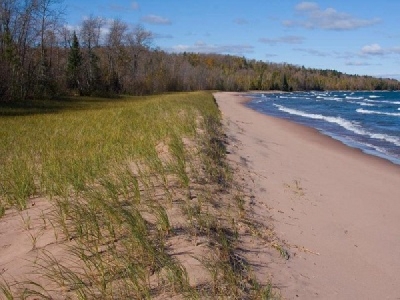
Posted on October 1, 2018
The Superior Watershed Partnership and Land Conservancy (SWP) announced the permanent protection of two unique coastal properties on Lake Superior totaling over 3,100 feet of sand beach that includes sensitive dune and swale habitat, coastal wetlands and stands of old growth forest.
Less than 13 percent of Lake Superior coastline is composed of sand beach with even less open to the public. The SWP is pleased to announce two new protected Lake Superior beaches that will soon be open to local residents and tourists alike.
“Every inch of Lake Superior shoreline is a treasure! By protecting these two high quality coastal properties the SWP is helping to preserve the integrity of this world class natural resource long into the future,” said David Ullrich, advisor and former Executive Director of the Great Lakes and St. Lawrence Cities Initiative and former Deputy Regional Administrator of US EPA, Great Lakes Region.
The grants are part of the Great Lakes Restoration Initiative (GLRI), a cooperative effort between federal, tribal, state and local partners. The U.S. Environmental Protection Agency funding administered by the U.S. Forest Service backs local efforts to protect high quality Great Lakes coastal wetland and forest habitats through the protection and establishment of Community Forests. Earlier in 2018 the SWP received a $400,000 GLRI Community Forest grant to acquire the Eagles Nest coastal property in Marquette County in the Upper Peninsula of Michigan. The Eagles Nest property is the first community forest in the program that includes Lake Superior coastline.
The Eagle’s Nest Community Forest is located 7 miles west of the city of Marquette and includes a variety of forest types and coastal wetlands including 1,130 feet of Lake Superior sand shoreline. Previously owned by the same family since the 1870’s, the Superior Watershed Partnership acquired the property and is currently developing a management plan. As a regional land conservancy the SWP will keep this property from proposed subdivision and development in perpetuity. The community forest will provide multiple educational and recreational opportunities for area residents and visitors year-round, including hiking and cross-country ski trails, nature-watching opportunities, and public access to unique and varied coastal ecosystems. The SWP Great Lakes Conservation Corps (GLCC) which employs young adults (18-25) will assist with trail design and trail construction for public access.
Recently, the SWP was awarded a second $400,000 GLRI Community Forest grant to acquire a high priority Lake Superior coastal property in Alger County including the mouth of the Laughing Whitefish River. The Laughing Whitefish Community Forest is located approximately 20 miles west of Munising and is dominated by forested uplands including old growth white pine, coastal wetlands, over 1,200 feet of the Laughing Whitefish River and over 2,000 feet of Lake Superior sand beach. The Laughing Whitefish Community Forest will also preserve important coastal ecosystems and provide educational and recreational opportunities for area residents and tourists.
The SWP is a local Great Lakes organization serving the communities and tribes of the Upper Peninsula of Michigan with emphasis on protecting and restoring the landscapes and rivers that drain to the surrounding waters of Lake Superior, Lake Michigan and Lake Huron. As a local organization the SWP includes over 30 seasonal Great Lakes Conservation Corps (GLCC) employees who complete a wide variety of environmental protection and restoration projects including; habitat restoration, trail construction, tree planting, wetland restoration, dune restoration, invasive removal, water quality monitoring and community pollution prevention projects. As a local land conservancy the SWP prioritizes the permanent protection of high quality riparian and coastal habitats of the Lake Superior, Lake Michigan and Lake Huron watersheds located in the Upper Peninsula of Michigan.
Source: Upper Michigan Source





